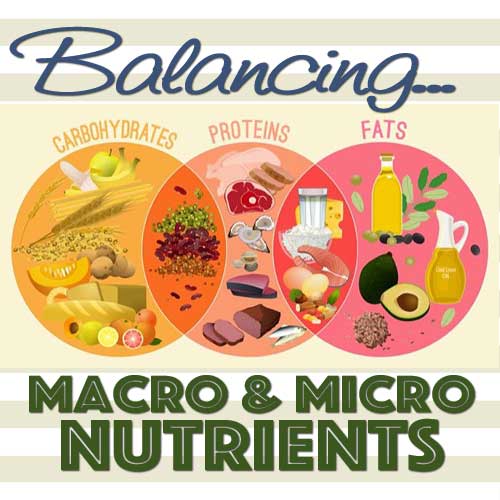Just a warning that this is going to be a long article. Writing about nutrition is such a vast subject that it would take me two lifetimes to write everything there is about it. In this article I am going to focus on macronutrients and micronutrients and the reasons we should know our balance and numbers. There are so many eating plans and they all tout one approach to eating without acknowledging the fact that everyone’s nutritional needs are different because our bodies are different. As someone with several chronic illnesses good nutrition is something that I strive for daily to maintain my health. My goals are different. Just like it would be different for an athlete or a nurse or someone who does not have a chronic condition.
Calories do not explain the whole picture when it comes to good nutrition. Calories measure the amount of energy that food and drinks contain. So, you can eat 100 calories of broccoli or 100 calories of a doughnut. Although the doughnut sounds delicious, you would be surprised to learn and see that 100 calories of a doughnut is only half a doughnut. But if we look at broccoli, 100 hundred calories is 4 cups. If you eat the doughnut, it does not fill you up for long. Yet, if you eat the broccoli and I don’t know anyone who can eat 4 cups of broccoli in one sitting you will be full longer and faster because of the fiber that it contains and other vital nutrients. If you are a calorie counter, break the habit of thinking a calorie is a calorie that way you are eating more nutritiously and mindfully. The nutritional value of food counts just as much as the calories.
Nutrients are divided into two categories Macronutrients and Micronutrients. Macronutrients are the nutrients that the body needs in large amounts. Micronutrients are nutrients that the body needs in smaller amounts.
Macronutrients are:
- Carbohydrates
- Proteins
- Fats
Micronutrients are:
- Vitamin B1
- Vitamin B2
- Vitamin B6
- Vitamin B 12
- Vitamin C
- Folic Acid
- Potassium
- Vitamin A
- Vitamin D
- Vitamin E
- Vitamin K
- Sodium
- Iron
- Water
- Zinc
I am going to start with information on macronutrients. There is a range for carbs, fats, and proteins people should be eating.
The ranges are:
Carbohydrates: 45 to 60 percent of your calories
Fats: 20 to 35 percent of your calories
Proteins: 10 to 35 percent of your calories
Carbohydrates contain 4 calories per gram, proteins contain 4 calories per gram, and fats contain 9 calories per gram. I am going to dive into more information about each macronutrient.
Carbohydrates:
They break down into glucose, which the body uses for its main energy source. Organs like the brain, need glucose to function. Carbohydrates also help amino acids (protein building blocks) and allow bowel movements to happen. Fiber is a type of carbohydrate. Carbohydrates are in two categories simple carbs and complex carbs. Simple carbs are easily broken down into glucose. Complex carbs take longer to break down into glucose. The role that carbs play in the body:
- Fuel high intensity exercises
- Spares protein from being used into energy so that it can preserve the muscle mass during exercise.
- Fuel the central nervous system (brain).
Foods that are carbohydrates:
- Grains
- Fruit
- Potatoes
- Peas
- Dairy
- Sugar
Protein:
Proteins help your body grow, build, and repair tissues. It also protects your lean body mass (your muscle mass). Protein is two different types of amino acids. The two types are essential amino acids and non-essential amino acids. Non-essential are the ones that your body makes without the aid of food. Essential are ones you must get by what you consume in your diet. The role of protein in your body:
- Helps in tissue structure, organs, muscles, hair skin, nails and bones, tendons, ligaments, blood plasma.
- Proteins are part of plasma membranes.
- Involved in metabolic transport and hormonal systems in the body.
- Makes up an enzyme that regulates the metabolism.
- Involved in acid and base balance to maintain neural environment in our bodies.
- Recommendation amounts are .36 grams per pounds of body weight of the person.
High in Protein Foods:
- Legumes
- Soy
- Animal products
- Nuts
- Meat
- Poultry
- Seeds
- Whole grains
Fats:
Fats allow you to store energy, cushion your organs, make certain hormones, absorb fat soluble vitamins like vitamin D. There are three types of fat:
- Trans fat, which needs to be cut out of your diet. This comes from hydrogenating or adding hydrogen molecules to unsaturated fat. Foods that have trans fat are margarine, shortening, baked goods, dough, fried foods.
- Saturated fat: This fat is found mainly in animal sources with high fat content like beef, lamb, pork, poultry, lard, cream, butter, cheese, and dairy.
- Unsaturated fat: this is the healthy fat that you find in plants. This fat decreases your risk of heart disease. Avocados, olives, nuts, but it can also be found in Salmon, Tuna, and sardines.
What fat does for the body:
- It reserves energy.
- Protects vital organs.
- Insulates the body.
- Transports fat soluble vitamins in the body.
- Vegans need to use a algae based Omega 3 so that they get this good fat that they can’t from plants.
Foods high in Fat:
- Oils
- Nuts
- Seeds
- Avocados
- Meat
- Fish
- Poultry
- Dairy
Micronutrients are vitamins and minerals that are bodies need in small quantities to function. Below are a list of micronutrients and what they do for the body and what foods have them:
- Vitamin B-1 (Thiamin): This vitamin is needed to release energy into the body. It also prevents thiamine deficiency. Foods that have this vitamin are wholegrains, dried beans, peas, peanuts, and animal proteins.
- Vitamin B-2 (Riboflavin): This vitamin is needed to maintain and build body tissues. Foods that have this vitamin are Green and yellow vegetables, animal proteins, and whole grains.
- Vitamin B-6 (Pyridoxine): This vitamin helps in development of nervous systems. It is also involved in the production of blood. It also helps in the break down of proteins and glucose to produce energy for the body. Foods that have this vitamin are potatoes, chickpeas, yeast, nuts, bulgur, fish, rice, and bananas.
- Vitamin B-12 (Cobalamin): This vitamin promotes growth and development of nervous systems. Foods that have this vitamin are Fortified cereals, fortified non-dairy milks, Fortified yeast, algae, animal products. Vegans need a b-12 supplement.
- Vitamin C (Ascorbic acid): This vitamin helps with hormones, is needed to build strong gums, teeth, and bones, and it is an antioxidant. Foods that have this vitamin are citrus fruits, cabbage, berries, and peppers.
- Folic Acid: This vitamin builds DNA and protein. It also maintains the intestinal tract. It is also needed for bone growth. It also prevents birth defects. Foods that have this vitamin are dark leafy vegetables, yeast, and wheat germ.
- Vitamin A (Retinal): This vitamin helps vision, helps keep skin healthy, and keeps your hair healthy. Foods have this vitamin are animal products, carrots, sweet potatoes, pumpkin, and red and orange vegetables.
- Vitamin D: This vitamin promotes strong teeth and bones. It also prevents rickets. Foods that have this vitamin mushrooms, dairy milk, fortified non-dairy milk, fortified cereals, cod liver oil, tuna, salmon, egg yolks, sunlight.
- Vitamin E: This vitamin prevents damage to cell membranes. Protects vitamin A, and aids in blood production. Foods that have this vitamin are seeds, nuts, and vegetable oils.
- Vitamin K: This vitamin aids in blood clotting. Foods that have this vitamin are green leafy vegetables.
- Calcium: This vitamin maintains teeth and bones. It also helps in blood clots. It also helps the nerves and muscles. Foods that have this vitamin are tofu, dark green vegetables, legumes, almonds, dairy, sardines, clams, and oysters.
- Potassium: This vitamin regulates water balance in the body. It also helps nerve function and is important for your heart rhythm. Foods that have this are oranges, bananas, cereal, potatoes, and dried beans.
- Sodium: This mineral regulates water balance in the body and stimulates the nerves. Foods that have this mineral are salt, bread, and everything.
- Iron: This vitamin forms blood cells. It also transports oxygen through the body. Foods that have this are fortified cereals, whole grains, legumes, lentils, nuts, seeds, dried fruits, and animal products.
- Zinc: This mineral aids in the transport of carbon dioxide. It also aids in healing wounds and it forms enzymes in the body. Foods that have this are whole grains, dairy milk, fortified non-dairy milk, and legumes.
- Water: This mineral keeps the tissues in the body moisturized. It also protects the bodies organs and tissues. It also prevents constipation. It also dissolves minerals and nutrients so the body can absorb them. It also regulates the body’s temperature. It lubricates the joints. It also lessons the burden on the kidneys and liver, by flushing waste products from them. It also carries oxygen and nutrients to all cells in the body.
Writing this article, I realize how overwhelming all this information is. I believe that if you focus on the macronutrients then you will get all the other minerals and vitamins in the micronutrient section. I also take specific vitamins and extra vitamin D because I know I am low from the blood work that my doctor does. If you would like a meal plan or encouragement, Karen at Wellness Works NW is a great asset to your wellness team.
If you would like help in creating a Wellness Plan, Karen and the Wellness Works NW Team are here to help you. Like our YouTube channel and our Facebook and Twitter pages and check out our website.
Here are some links I would like to share with you:
- The Best Macronutrient Ratio for Weight Loss by Gavin Van De Walle, MS, RD on September 2, 2018 for Healthline
- Macro Calculator: Count Your Macros Like a Pro! by BodyBuilding.com Staff
- Macronutrients by United States Department of Agriculture National Agricultural Library Staff
- Photo Credit: Macronutrients: A Simple Guide To Macros by Avita Health System Staff
- Micronutrient Facts by Centers for Disease Control and Prevention Staff
- Nutrition Basics by Washington State University Staff
Related Articles:
- Korean Nutrition
- Nutrition, How do I Help My Children With This?
- The Benefits of a High Starch Diet
- The Popcorn Article
- Learning About Sugar Awareness
To look for a particular topic please see our Healthy Living Blogs page. If you don’t find what you are looking for please click on the button below to fill out a request form and someone from Our Team will be glad to research it for you for FREE!
 Jamie Holloway is a co-owner of Wellness Works NW and she is also our Research Manager and writes our Chasing Wellness with Jamie Holloway and Dear Jamie columns. Jamie is also an Independent Wellness Advocate at dōTERRA. She lives in the Portland, Oregon area. Since October 2011 she has been sharing her Journey Toward Health and Wellness with Vasculitis through her blog at JamieChasesButterflies.com. We hope you are as inspired as we are with the raw candor Jamie uses in her writing. If you would like to help support Jamie’s writing efforts please Donate now.
Jamie Holloway is a co-owner of Wellness Works NW and she is also our Research Manager and writes our Chasing Wellness with Jamie Holloway and Dear Jamie columns. Jamie is also an Independent Wellness Advocate at dōTERRA. She lives in the Portland, Oregon area. Since October 2011 she has been sharing her Journey Toward Health and Wellness with Vasculitis through her blog at JamieChasesButterflies.com. We hope you are as inspired as we are with the raw candor Jamie uses in her writing. If you would like to help support Jamie’s writing efforts please Donate now.













